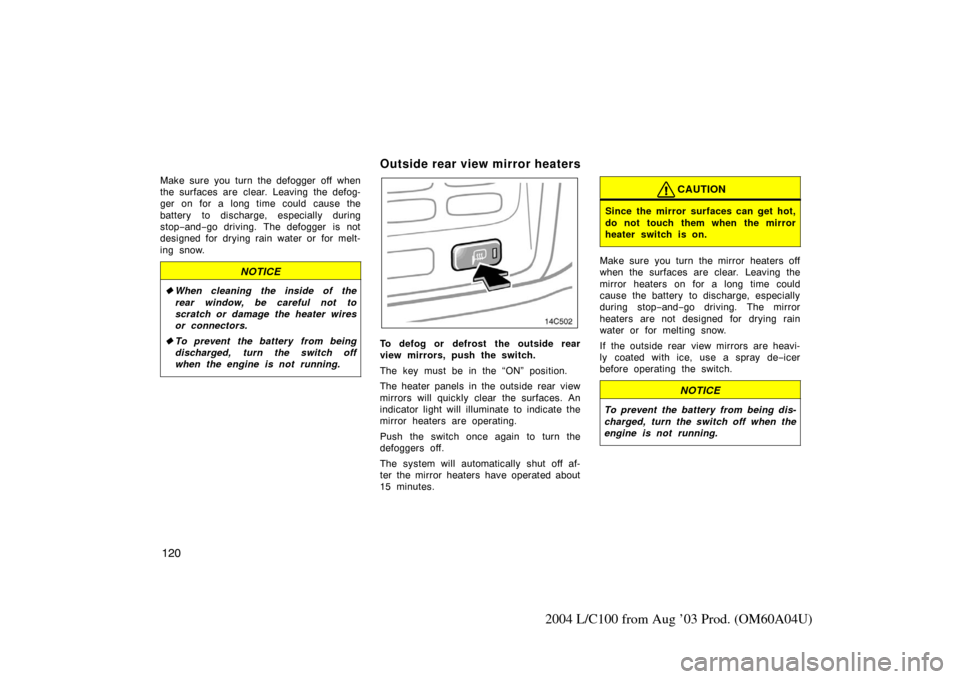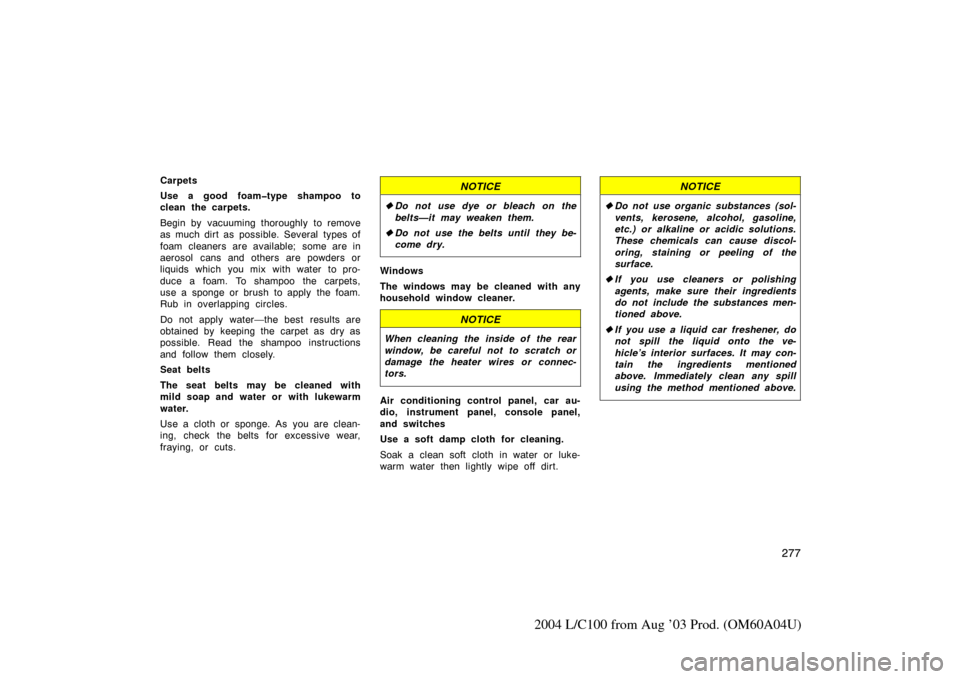Page 128 of 342

120
2004 L/C100 from Aug ’03 Prod. (OM60A04U)
Make sure you turn the defogger off when
the surfaces are clear. Leaving the defog-
ger on for a long time could cause the
battery to discharge, especially during
stop−and− go driving. The defogger is not
designed for drying rain water or for melt-
ing snow.
NOTICE
� When cleaning the inside of the
rear window, be careful not to
scratch or damage the heater wires
or connectors.
� To prevent the battery from being
discharged, turn the switch off
when the engine is not running.
Outside rear view mirror heaters
To defog or defrost the outside rear
view mirrors, push the switch.
The key must be in the “ON” position.
The heater panels in the outside rear view
mirrors will quickly clear the surfaces. An
indicator light will illuminate to indicate the
mirror heaters are operating.
Push the switch once again to turn the
defoggers off.
The system will automatically shut off af-
ter the mirror heaters have operated about
15 minutes.
CAUTION
Since the mirror surfaces can get hot,
do not touch them when the mirror
heater switch is on.
Make sure you turn the mirror heaters off
when the surfaces are clear. Leaving the
mirror heaters on for a long time could
cause the battery to discharge, especially
during stop− and−go driving. The mirror
heaters are not designed for drying rain
water or for melting snow.
If the outside rear view mirrors are heavi-
ly coated with ice, use a spray de −icer
before operating the switch.
NOTICE
To prevent the battery from being dis-
charged, turn the switch off when the
engine is not running.
Page 234 of 342

226
2004 L/C100 from Aug ’03 Prod. (OM60A04U)
Cold tire inflation pressureTire inflation pressure when the vehicle has been parked at least 3 hours or
more, or it has not been driven more than 1.5 km or 1 mile under that condition
Maximum inflation pressureThe maximum cold inflation pressure to which a tire may be inflated and shown
on the sidewall of the tire
Recommended inflation pressureCold tire inflation pressure recommended by a manufacturer
Accessory weight
The combined weight (in excess of those standard items which may be re-
placed) of automatic transmission, power steering, power brakes, power win-
dows, power seats, radio, and heater, to the extent that these items are avail-
able as factory −installed equipment (whether installed or not)
Curb weight
The weight of a motor vehicle with standard equipment including the maximum
capacity of fuel, oil, and coolant, and, if so equipped, air conditioning and addi-
tional weight optional engine
Maximum loaded vehicle weight
T he sum of —
(a) Curb weight;
(b) Accessory weight;
(c) Vehicle capacity weight; and
(d) Production options weight
Normal occupant weight68 kg (150 lb.) times the number of occupants specified in the second column
of Table 1 that follows
Production options weight
The combined weight of those installed regular production options weighing
over 2.3 kg (5 lb.) in excess of those standard items which they replace, not
previously considered in curb weight or accessory weight, including heavy duty
brakes, ride levelers, roof rack, heavy duty battery, and special trim
— Tire relat ed terms
Page 285 of 342

277
2004 L/C100 from Aug ’03 Prod. (OM60A04U)
Carpets
Use a good foam�type shampoo to
clean the carpets.
Begin by vacuuming thoroughly to remove
as much dirt as possible. Several types of
foam cleaners are available; some are in
aerosol cans and others are powders or
liquids which you mix with water to pro-
duce a foam. To shampoo the carpets,
use a sponge or brush to apply the foam.
Rub in overlapping circles.
Do not apply water—the best results are
obtained by keeping the carpet as dry as
possible. Read the shampoo instructions
and follow them closely.
Seat belts
The seat belts may be cleaned with
mild soap and water or with lukewarm
water.
Use a cloth or sponge. As you are clean-
ing, check the belts for excessive wear,
fraying, or cuts.NOTICE
�Do not use dye or bleach on the
belts—it may weaken them.
� Do not use the belts until they be-
come dry.
Windows
The windows may be cleaned with any
household window cleaner.
NOTICE
When cleaning the inside of the rear
window, be careful not to scratch or
damage the heater wires or connec-
tors.
Air conditioning control panel, car au-
dio, instrument panel, console panel,
and switches
Use a soft damp cloth for cleaning.
Soak a clean soft cloth in water or luke-
warm water then lightly wipe off dirt.
NOTICE
�Do not use organic substances (sol-
vents, kerosene, alcohol, gasoline,
etc.) or alkaline or acidic solutions.
These chemicals can cause discol-
oring, staining or peeling of the
surface.
� If you use cleaners or polishing
agents, make sure their ingredients
do not include the substances men-
tioned above.
� If you use a liquid car freshener, do
not spill the liquid onto the ve-
hicle’s interior surfaces. It may con-
tain the ingredients mentioned
above. Immediately clean any spill
using the method mentioned above.
Page 331 of 342

323
2004 L/C100 from Aug ’03 Prod. (OM60A04U)
Service specifications
ENGINE
Valve clearance (engine cold), mm (in.):Intake 0.15—0.25 (0.006—0.010)
Exhaust 0.25—0.35 (0.010—0.014)
Spark plug type: DENSO SK20R11
NGK IFR6A11
Spark plug gap, mm (in.): 1.1 (0.043)
ENGINE LUBRICATION
Oil capacity (drain and ref ill), L (qt., Imp.
qt.) With filter 6.8 (7.2, 6.0)
Without filter 6.4 (6.8, 5.6)
Oil grade:
“Toyota Genuine Motor Oil” is filled in
your Toyota vehicle. Use Toyota ap-
proved “Toyota Genuine Motor Oil” or
equivalent to satisfy the following grade
and viscosity.
Oil grade:
API grade, SL “Energy −Conserving” or
ILSAC multigrade engine oil Recommended oil viscosity:
SAE 5W −30
Temperature range anticipated before
next oil change
Please contact your Toyota dealer for fur-
ther details. COOLING SYSTEM
Total capacity, L (qt., Imp. qt.)
Without rear heater 14.7 (15.5, 12.9)
With rear heater 15.4 (16.3, 13.6)
Coolant type:
“Toyota Super Long Life Coolant” is filled
in your Toyota vehicle at factory fill. In
order to avoid technical problems, only use
“Toyota Super Long Life Coolant” or similar
high quality ethylene glycol based non −sili-
cate, non −amine, non− nitrite, and non− bo-
rate coolant with long −life hybrid organic
acid technology.
Do not use plain water alone.
Please contact your Toyota dealer for fur-
ther details.
BATTERY
Open voltage
∗ at 20 C (68 F):
12.6—12.8 V Fully charged
12.2—12.4 V Half charged
11.8—12.0 V Discharged
∗: Voltage that is checked 20 minutes af-
ter the key is removed with all the lights
turned off
Charging rates:
5 A max.
Page 336 of 342

328
2004 L/C100 from Aug ’03 Prod. (OM60A04U)
26. HEAD (LH�LWR) 10 A: Left−hand head-
light (low beam)
27. HEAD (RH�UPR) 20 A: Right−hand
headlight (high beam)
28. HEAD (LH�UPR) 20 A: Left−hand head-
light (high beam)
29. PWR OUTLET 15 A: Power outlets
30. CIG 15 A: Cigarette lighter
31. ACC 7.5 A: Instrument panel light
32. AM1 7.5 A: Multiport fuel injection sys-
tem/Sequential multiport fuel injection
system
33. DEFOG 20 A:
Rear window defogger
34. AHC�B 15 A: Active height control sus-
pension (AHC)
35. FUEL HTR 20 A: Fuel heater
36. POWER HTR 7.5 A: Power heater
37. AHC�IG 20 A: Active height control sus-
pension (AHC)
38. EFI or ECD No.2 10 A: Emission control
system
39. GAUGE1 10 A: Gauges and meters
40. ECU�IG1 10 A: Multiport fuel injection
system/S equential multiport fuel injec-
tion system
41. ECU�B1 10 A:
Navigation system
42. DBL LOCK 15 A: Double lock system
43. BATT CHARGE 30 A
44. A/C 15 A:
Air conditioning system
45. STOP 15 A: Stop lights
46. OBD�2 7.5 A: On−board diagnosis system
47. IDEL UP 7.5 A: Idle−up system
48. LH SEAT 30 A: Power seat system
49. DOOR 25 A: Power door lock system,
Power windows
50. SUN ROOF 25 A: Electronic moon roof
51. RR WIPER 15 A: Rear wiper system
52.ECU�B2 10 A: Power door lock system,
Power window
53. DIFF 20 A: Four−wheel drive system
54. WASHER 15 A: Windshield washer
55. RADIO 10 A: Audio system
56. DOME 10 A: Interior lights
57. VGRS 40 A: Variable gear ratio steer-
ing system
58. P/W (FL) 20 A: Power window
59. P/W (RL) 20 A: Power window
60. WIPER 25 A: Windshield wiper
61. ECU�IG2 10 A: Rear air conditioning
system
62. SEAT HTR 15 A: Seat heater 63. GAUGE2 10 A:
Back−up lights
64. MET 7.5 A: Gauges and meters
65. IGN 7.5 A: Multiport fuel injection sys-
tem/Sequential multiport fuel injection
system
66. SECURITY 7.5 A: Theft deterrent sys-
tem
67. P/W (RR) 20 A: Power window
68. P/W (FR) 20 A: Power window
69. TIL&TEL 20 A: Tilt and telescopic
steering
70. RR A/C 30 A: Rear air conditioning
system
71. RH SEAT 30 A: Power seat system